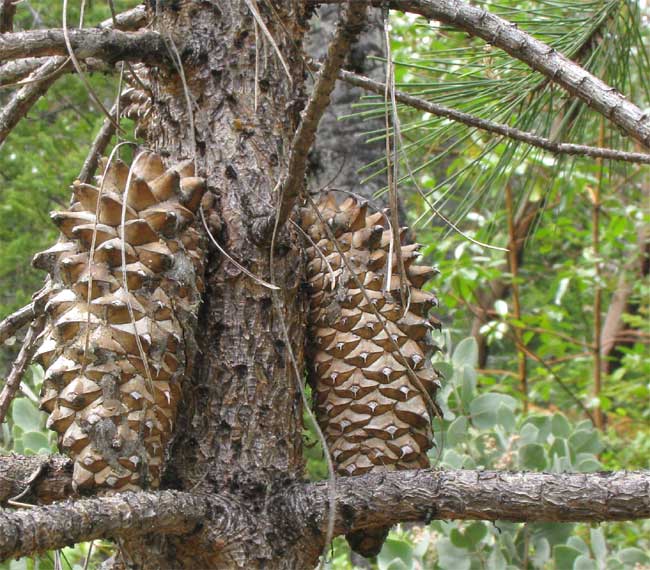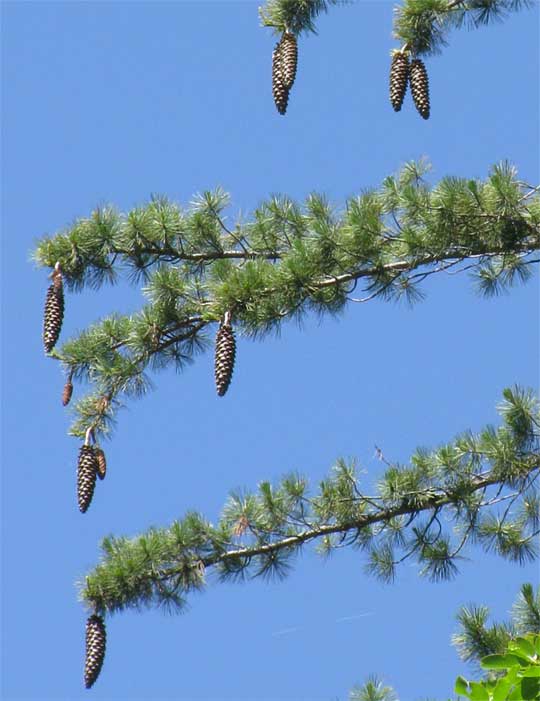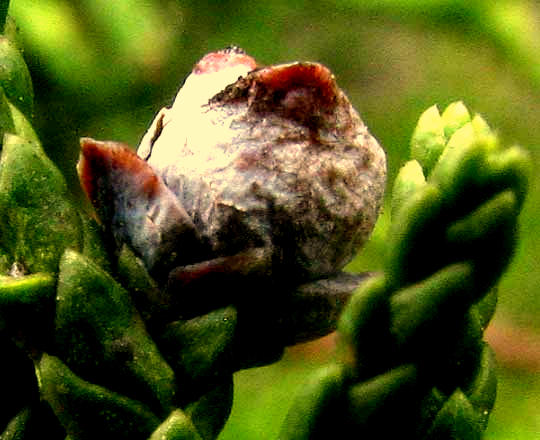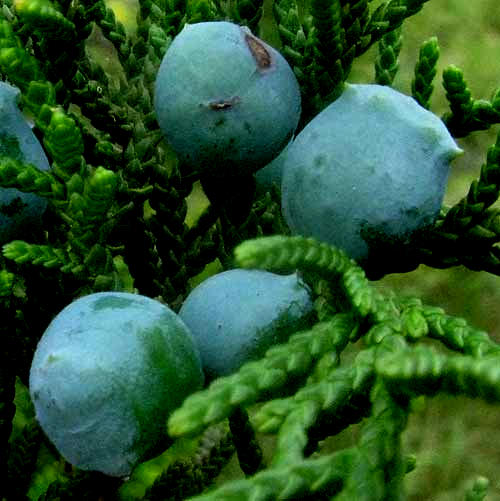
Though only 600 to 630 species of conifers are thought to exist -- as compared to maybe 300,000 species of flowering plants, the angiosperms -- ecologically conifers are of enormous importance. They're dominant species in the Northern Hemisphere's taiga region, which occupies about 17% of the Earth's land surface, plus they're principle trees at cool higher elevations. About 29% of the Earth's land area lies above 1000 meters (3200 ft). Around people's homes conifers often are planted because they're green year round and display pleasing forms.

In your backyard, if you have a pine tree such as the Knobcone Pine, Pinus attenuata, shown at the left, or a spruce, fir, Douglas-fir, hemlock, cedar, yew, larch, juniper, Monkey-puzzle Tree, Norfolk Island Pine, or Bald Cypress, -- all trees or bushes sometimes found in backyards -- you're living next to a conifer.
Often conifers are thought of as trees or bushes which bear cones and evergreen, needle-like or scale-like leaves. However, those features are shared by certain other non-conifer species. The best we backyard naturalists can do to know what's a conifer and what's not is to remember this:
 Cones on Sugar Pine, Pinus lambertiana
Cones on Sugar Pine, Pinus lambertianaAll living conifer species belong to six plant families. Of those six families, only three might appear in many Temperate Zone backyards in the Northern Hemisphere. Those three families are:
- THE PINE FAMILY, the Pinaceae
- pines
- spruces
- firs
- hemlocks
- larches
- cedars
- THE YEW FAMILY, the Taxaceae
- Yews
- THE CYPRESS FAMILY, the Cupressaceae
- junipers
- redwoods
CONIFER CONES NOT PINE CONES

On our What's a Gymnosperm page, we note that a little over 60% of all gymnosperm species are conifers. All those species produce reproductive cones, and the appearance and structure of those cones varies a great deal. Most of us know what a typical pine cone -- more technically referred to as a seed cone -- looks like. The one at the left is that of the Loblolly Pine, Pinus taeda, with three winged seeds.

At the right is the cone and three seeds of another conifer, not of a pine (genus Pinus), but rather of another genus in the Pine Family, that of Pseudotsuga. It's the Douglas-fir, Pseudotsuga menziesii. The cone is similar to a pine cone, but note those curious "rat tails" hanging down over each cone scale. Pine cones simply don't have those. In the Pine Family, cones are composed of two kinds of scales, bract scales and seed scales. In pine cones the bract scales stay hidden, but with the Douglas-Fir they hang out, looking like rat rear ends.

Mature, semi-woody, seed-dropping pine cones and Douglas-fir cones are "seed cones," with the seeds starting out as ovules in the immature female cone, or female strobilus, as it's more technically called. Conifers also produce male cones, and most conifer species produce both male and female cones on the same trees -- they're monoecious. Of course, the male cones produce pollen. At the left, those curling, "yellow worms" are pollen cones on the Loblolly Pine, Pinus taeda. They fall off once their pollen is shed. We don't think of them as pine cones, but they are, just pollen-producing ones.

Another cone type is shown at the right. That's a mouse's-eye-size ovulate cone -- the first stage of a cone when there are ovules not yet developed into seeds. That cone is on an Ashe Juniper, Juniperus ashei. At pollination time, most people never notice female cones because they're so inconspicuous.

Once pollinated, the above Ashe Juniper cone matures into a "juniper berry," such as those shown at the left which, despite their looks, are real gymnosperm cones. One reason they look so different from cones in the Pine Family is that junipers are members of the Cypress Family, one of the other two non-pine families of conifers likely to be found in many backyards. In the Cypress Family, the earlier-mentioned bract and seed scales, instead of staying separate as in the Pine Family, fuse together. Juniper cones are so distinctive that often the more technical term of galbulus (plural galbuli) is used for them. If you've ever seen birds such as Cedar Waxwings gobble down juniper berries, you can guess at the adaptive advantage a fleshy juniper galbulus has over a simple winged pine seed.

An Ashe Juniper's pollen-producing male cones are shown at the right. These cones are much smaller than the pine's long, yellow-worm-like male cones noted earlier, but they're much more numerous on the tree. In fact, Ashe Junipers produce prodigious quantities of pollen, as seen below where a breeze is kicking up a great, smoke-like cloud of Ashe Juniper pollen.

The Yew Family, the other none-Pine-Family producing conifer species, besides the junipers' Cypress Family, produces maybe even more outlandish-looking cones than junipers.

At the right two of a yew bush's highly modified seed cones each contain a single seed partly surrounded by a modified soft and juicy cone scale called an aril. The top seed in the picture has part of the aril removed to show the seed's obligatory "nakedness" -- it's not being completely covered by anything -- which is exactly right for all gymnosperm seeds. Seeds nested in such showy arils are favorite food for such birds as thrushes and waxwings, and numerous species, even among flowering plants, have them.